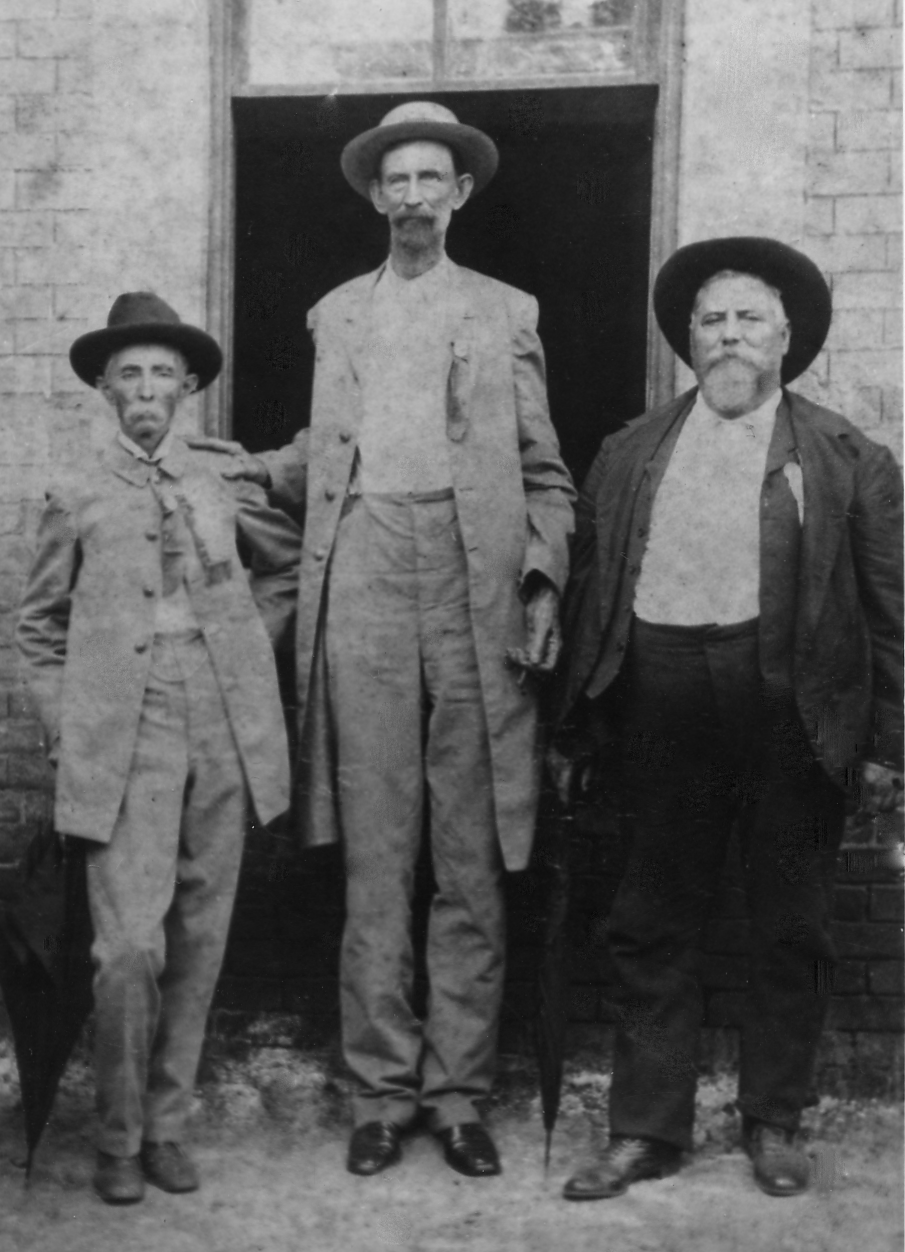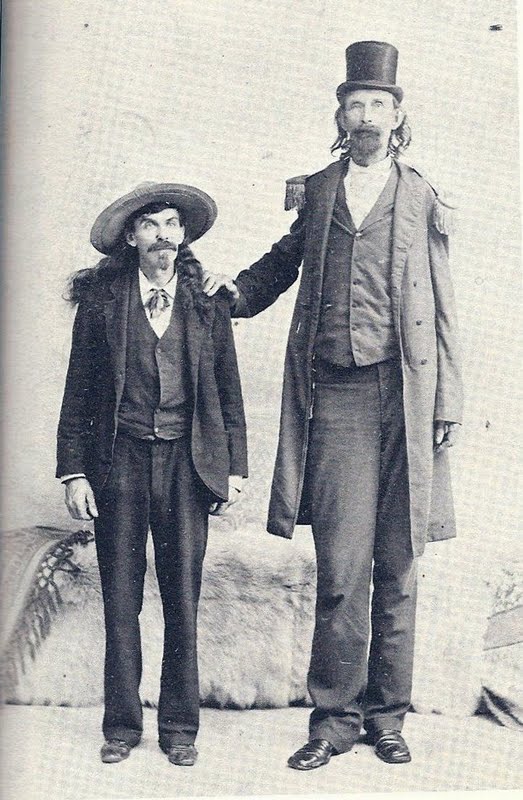_edited-3.jpg)


Birth Date: November 6, 1827
Died: March 29, 1908
Spouse: Eliza Baxter Harris
Biography:
Henry Clay Thruston was beyond a doubt the tallest man in the Confederate Army, and was perhaps during the time that he lived, one of the tallest men in the world. He was 7 feet 7 inches tall.
His name has been spelled “Thruston”, “Thurston” and “Thouston”, but It Is believed that “Thouston” is the correct spelling. There is a deed recorded in Vol. 19, Page 171, of the Deed Records of Titus County, Texas, dated March 30, 1889, n which he is selling land, and the record of that deed shows it to be signed as “Thouston”.
Facts relative to his early life and service in the Confederate Army are best set out in an article appearing in the Confederate Veteran magazine, December, 1909 issue, following his death. That article is as follows:
“H. C. THRUSTON, TALLEST MAN IN THE WORLD.”
“The Texas giant and the world’s tallest man died at the home of his son, Edward, in Mount Vernon, Texas, soon after his return from the last Confederate Reunion in Memphis, Tennessee, at the age of seventy-nine years.
In 1832, there migrated from South Carolina and settled in the western portion of Morgan County, Mo., then sparsely settled, a family remarkable for its uplifting and moral influence and for the physical stature of its men. Five sons ranged in height from six feet six inches to seven feet seven and a hall Inches. When the great war began, the family espoused the case of the South, and its members never faltered until the end came. In the spring of 1861, George Butler, who married a Miss Thruston, organized the Morgan County Rangers, and was elected as its captain, with Sid Thruston as a lieutenant, Hal Thruston a sergeant, and H. C. Thruston as a private.
When the Federal General Lyons invaded Missouri, he broke up the Legislature and drove the Governor, Claiborne F. Jackson, from the Capitol. He also took prisoners a company of State Guards in St. Louis, shot down women and children in the streets, and proclaimed that the blood of women and children should run as water before Missouri should go out of the Union. Jim Lane and Jennison, the noted Kansas Jayhawkers, were commissioned officers of the United States army, although the government had pursued them all over Kansas, and their leader, John Brown, bad been captured at Harper’s Ferry, Va., and executed. These outlaws advanced at the head of the United States troops, and plundered and burned as they went.
The Morgan County Rangers, eighty strong, went forth under Captain Butler. to defend their homes and property. Mrs. Butler upon a cot was carried into the streets of Versailles, Mo., to say farewell to the company; and when our gallant captain, with streaming eyes and frame quivering with emotion, parted with her, she was calm as a summer’s evening, caressed him, and told him to go and fight for his country and remember he was from South Carolina. She soon passed away. Somewhere in the South in an unmarked soldier’s grave is Colonel Butler. It is ‘Fame’s eternal camping ground.’
H. C. Thruston remained with the State Guards until after the battle of Pea Ridge, in which Joe Thurston, a nephew, was killed. The Missouri troops, under Generals Van Dorn and Price, were ordred east of the Mississippi River. In one of the fights after this H. C. Thruston was well in advance. The enemy was camped near a house from which a woman ran out shrieking, ‘Run, boys, run; the woods are full of them.’ Tom Tipton, a noble boy who was shortly afterwards killed, called out to her: ‘Go In the house and get under the bed, or you will be killed.’ About that time Thruston caught sight of their major running, and fired upon him. The major lived long enough to tell that he saw the man who shot him while ‘standing upon a stump.’ After that we were transferred to the 4th Missouri Cavalry, Manna- duke’s command, then at Batesviie, Ark., and soon we started the Cape Girardeau raid. John Q. Burbridge was lieutenant colonel under Col. W. I. Preston. The next day we were on dress parade; and when Colonel Preston gave the command, ‘Attention!’ he ordered Thruston to ‘get off that stump.’ He gave this command the second time; but as nobody moved, he drew his saber and declared: ‘I will make you obey orders.’ He came running right at Thruston and said: ‘What are you standing on? Thruston replied: ‘I am standing on the ground.’ Thruston was afterwards wounded in the side at Poison Springs, Ark., and, strange to say, a bullet grazed the top of his head on Price’s Missouri raid.”
He is buried in the old cemetery in Mt. Pleasant, and on his monument it says that he was born May 14, 1833 and died July 2, 1911. This inscription with reference to his having died in 1911 is certainly in error as the report of his death and a picture appears in the Confederate Veteran magazine of December 1909. There are also buried in the cemetery his wife, Mary, who was born May 14, 1833 and died September 23, 1891; and two of their sons.
It is not known when Henry Clay Thruston first came into Titus County, but a search of the Deed Records shows that he bought 160 acres of land from Ann Hunt on September 12, 1874. This deed is recorded in Vol.14, Page 287, of the Deed Records of Titus County. This land is located in the northwestern part of the country just south of White Oak Creek, and Thouston continued to buy other lands in that area until at one time he owned several hundred acres. A portion of this land is still owned by his grandson. He lived on these lands until his last few years when, due to his health, he moved into Mt. Vernon and lived there with his son, Edward, until the time of his death.
He was known among his acquaintances in this area as Colonel Thouston. It seems that practically all Confederate veterans in their later years either became Major or Colonel. His acquaintances pronounced his name as “Thuston. For many years following the Civil War, he spent most of his time in traveling with circuses, and was always billed in these side shows as being “The World’s Tallest Man”. In order to accent his height, he wore a tall beaver hat, high-top boots and a long coat. As one of his acquaintances said: “This made him look to be 10 feet tall”. In those days, one of the big events of a circus coming to town was the parade through the downtown section, and when the circus that Thouston was with was showing in any of the Confederate States, he would always walk in the lead of the parade carrying a large Confederate flag over his shoulder, and this was one of the most popular things of the parade. Then on the other band, when they were showing in a Union State, he would usually lead the parade, dressed as Uncle Sam, and carrying both the Union and Confederate Flags. Judge R. T. Wilkinson, of Mt. Vernon, was perhaps one of his closest acquaintances in this area, and he says that Col. Thouston was a vain old fellow and proud of his height, and was always willing and ready to recount events of the Civil War and of his life. The Judge says that his hands were as big as hams and his feet were so large that he had to have his shoes specially made. He rode horseback quite a bit and when he was riding a small horse, his knees were usually pulled up as high as the horse’s back in order thak his feet would not drag the ground. He had a buggy specially built for him with the seat built high up in order that he could ride more comfortably. In fact, Judge Wilkinson said that the old fellow always took great pains to call attention to his great height.